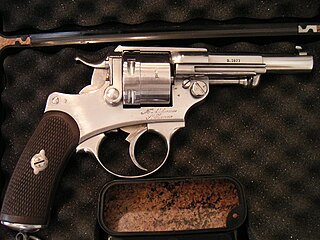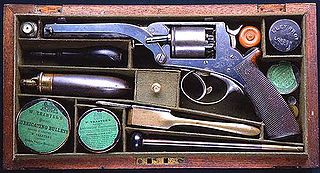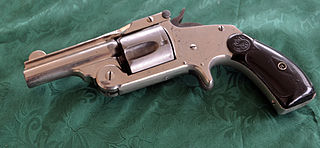
A revolver is a repeating handgun that has at least one barrel and uses a revolving cylinder containing multiple chambers for firing. Because most revolver models hold up to six cartridges, before needing to be reloaded, revolvers are commonly called six shooters or sixguns. Due to their rotating cylinder mechanism, they may also be called wheel guns.

The Colt Single Action Army is a single-action revolver handgun. It was designed for the U.S. government service revolver trials of 1872 by Colt's Patent Firearms Manufacturing Company and was adopted as the standard-issued pistol of the U.S. Army from 1873 to 1892.

The Colt Anaconda is a large frame double-action revolver featuring a full length under-barrel ejection-rod lug and six round cylinder, designed and produced by the Colt's Manufacturing Company in 1990. Chambered for the powerful .44 Magnum and .45 Colt centerfire ammunition cartridges, the Anaconda marked the Hartford, Connecticut firm's first foray into the popular large-bore Magnum pistol market.

Ethan Allen was a major American arms maker from Massachusetts. He is unrelated to the revolutionary Ethan Allen. His first firearm, the "Pocket rifle" was developed in 1836, and his first patent was granted in 1837.

The Mannlicher M1894 was an early blow-forward semi-automatic pistol.

The Walther P38 is a 9 mm semi-automatic pistol that was developed by Carl Walther GmbH as the service pistol of the Wehrmacht at the beginning of World War II. It was intended to replace the comparatively complex and expensive to produce Luger P08. Moving the production lines to the more easily mass producible P38 once World War II started took longer than expected, leading to the P08 remaining in production until September 1942 and copies remained in service until the end of the war.

The Moschetto Automatico Revelli-Beretta Mod. 1915 was a self-loading carbine that entered service in 1918 with the Italian Armed Forces. Designed as a semi-automatic carbine, the weapon came with an overhead inserted magazine, an unconventional design based on the simplicity of allowing a spent round to be replaced using assistance from gravity. The gun was made from half of a Villar-Perosa aircraft submachine gun.

Harrington & Richardson Arms Company is an American brand of firearms and a subsidiary of JJE Capital Holdings. H&R ceased independent production February 27, 2015.

The Smith & Wesson Model 15, initially the Smith & Wesson K-38 Combat Masterpiece, is a six-shot double-action revolver with adjustable open sights produced by Smith & Wesson on the medium-size "K" frame. It is chambered for the .38 Special cartridge and is fitted with a 4-inch (100 mm) barrel, though additional barrel options have been offered at various times during its production. It is essentially a shorter barrel version of the Smith & Wesson Model 14 and an adjustable-sight version of the seminal Smith & Wesson Model 10 with target shooting features.

The Remington-Beals Model Revolvers along with subsequent models and variations were percussion revolvers manufactured by Eliphalet Remington & Sons in .31 (Pocket) .36 (Navy) or .44 (Army) caliber, used during the American Civil War, and was the beginning of a successful line of medium and large frame pistols. They are commonly, though inaccurately, referred to as the Model 1858 due to the patent markings on its New Model barrels, "PATENTED SEPT. 14, 1858/E. REMINGTON & SONS, ILION, NEW YORK, U.S.A./NEW MODEL."; although wide scale production did not start until 1861.

A handgun is a firearm designed to be usable with only one hand. It is distinguished from a long gun which needs to be held by both hands and braced against the shoulder. Handguns have shorter effective ranges compared to long guns, and are much harder to shoot accurately. While most early handguns are single-shot pistols, the two most common types of handguns used in modern times are revolvers and semi-automatic pistols, although other handguns such as derringers and machine pistols also see infrequent usage.
Llama Firearms, officially known as Llama-Gabilondo y Cia SA, was a Spanish arms company founded in 1904 under the name Gabilondo and Urresti. Its headquarters were in Eibar in the Basque Country, Spain, but they also had workshops during different times in Elgoibar and Vitoria. The company manufactured moderate-priced revolvers and self-chambering pistols in a wide variety of models. These were popular mainly in the European and Latin American export market, as well as domestically in Spain.

The Colt New Service is a large frame, large caliber, double-action revolver made by Colt from 1898 until 1941. Made in various calibers, the .45 Colt version with a 5½" barrel, was adopted by the U.S. Armed Forces as the Model 1909.

The Glisenti Model 1910 was a 9 mm calibre semi-automatic service pistol produced by the Italian company Società Siderurgica Glisenti. It was put in production in 1910 to replace the aging Bodeo Model 1889. It saw extensive service in World War I and World War II with the Royal Italian Army. The Model 1910 has a complex and weak firing system which mandates that the pistol ought to use weaker cartridges than pistols of comparable calibre.

The service revolver model 1873 Chamelot-Delvigne was the first double-action revolver used by the French Army. It was produced by Manufacture d'armes de Saint-Étienne from 1873 to 1887 in about 337,000 copies. Although replaced by the Modele 1892 revolver, it was nevertheless widely used during the First World War and issued to reserve units in 1940. The French Resistance made widespread use of it during the German occupation.

The Tranter revolver was a double-action cap & ball revolver invented around 1856 by English firearms designer William Tranter (1816–1890). Originally operated with a special dual-trigger mechanism later models employed a single-trigger mechanism much the same as that found in the contemporary Beaumont–Adams revolver.

The Smith & Wesson Model 1+1⁄2 was Smith & Wesson's second .32 caliber revolver, intended to combine the small size and convenience of the .22 caliber Model 1 with the larger caliber of the 6-shot "belt sized" Model 2, which was introduced in 1861. Chambered in .32 Rimfire, its cylinder held 5 shots. It was produced in three varieties from 1865 through 1892, with total production exceeding 223,000.

The Smith & Wesson Model 2, also referred to as the Smith & Wesson .38 Single Action, was a .38 caliber revolver produced in both single and double action by Smith & Wesson. The manufacturer's first of that caliber, its 5-shot cyclinder was chambered in .38 S&W. The single-action was produced in three varieties from 1876 through 1911, with total production exceeding 223,000 units; the double-action in three variants from 1880 to 1913, with total sales somewhat under one-million guns.

In 1854, Frenchman Eugene Lefaucheux introduced the Lefaucheux Model 1854, notable as being the first revolver to use self-contained metallic cartridges rather than loose powder, pistol ball, and percussion caps. The M1854 model was a single-action, pinfire revolver holding six rounds. It was a French military revolver chambered for the 12 mm pinfire cartridge, based on a design by Casimir Lefaucheux. The M1854 revolver spawned numerous variants, some of which were produced under license in other countries. It was widely exported during the 1860s and sold as both a military and civilian sidearm with either a short or long barrel. Most military models were produced only as single-action weapons, whereas civilian models were made primarily as double-action weapons.

The Beretta Model 1915 or Beretta M1915 is a semi-automatic pistol manufactured by Beretta, designed by Tullio Marengoni who was the chief engineer in the company, to replace the Glisenti Model 1910 which had a complex and weak firing mechanism. It is the first semi-automatic pistol, manufactured by the company, and issued as a service pistol in Royal Italian Army during World War I. The total production of the Beretta M1915 is estimated about 350 during 1915-1918, and about 480 of Beretta M1915/1917. Some of the pistols were also used in World War II until 1945. Its open slide design later became the characteristic for other Beretta pistols such as Beretta M1923, Beretta M1934, Beretta M1935, Beretta M1951, Beretta 70, Beretta 92, Beretta Cheetah, and Beretta M9.





















